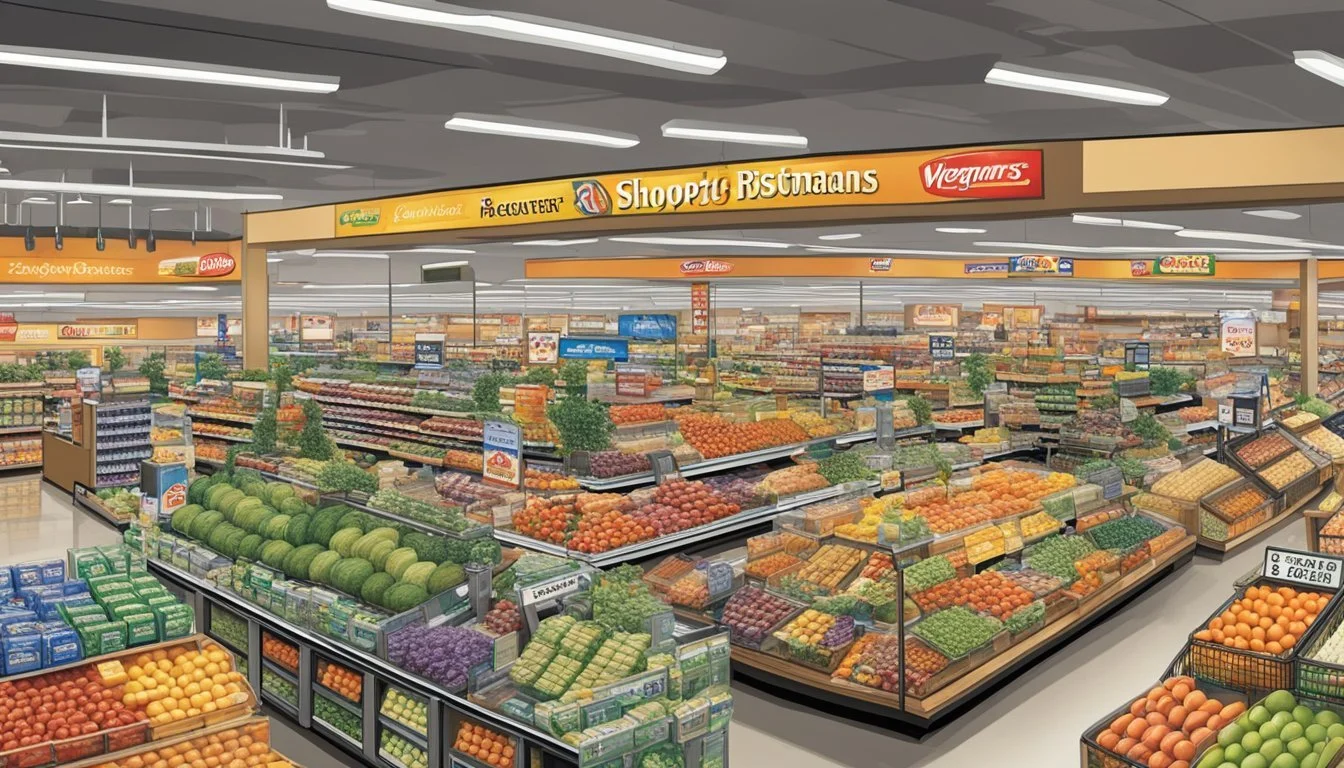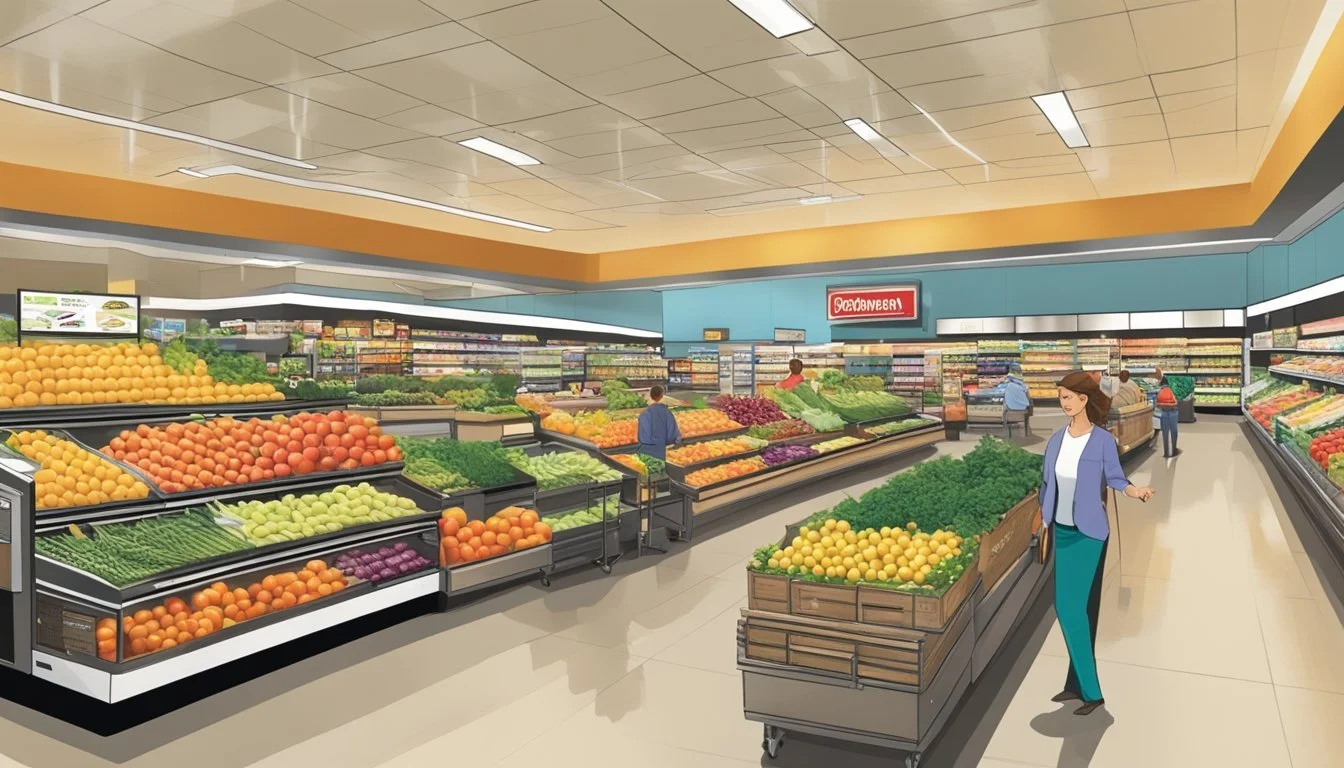Shoprite vs Wegmans
A Comprehensive Comparison of Prices, Quality, and Selection
Shoprite and Wegmans are two popular grocery store chains that cater to different consumer preferences. Shoprite focuses on providing affordable options and extensive coupon offerings, while Wegmans emphasizes product quality and an enhanced shopping experience. Shoprite tends to be more budget-friendly, with prices approximately 18% lower than Wegmans on average.
Both supermarkets offer a wide selection of fresh produce, meats, and other essentials. Wegmans stands out for its larger organic selection and higher-end specialty items. Shoprite, on the other hand, excels in conventional grocery offerings and competitive pricing across staple products.
The choice between Shoprite and Wegmans ultimately depends on individual shopper priorities. Consumers seeking the lowest prices and best deals may prefer Shoprite, while those valuing a more upscale atmosphere and diverse product range might opt for Wegmans. Both stores have loyal customer bases and continue to compete for market share in the grocery retail sector.
Company Backgrounds
ShopRite and Wegmans are two prominent grocery chains with rich histories spanning decades. Both companies have grown from humble beginnings to become major players in the retail food industry, each with its own unique approach and regional focus.
History of ShopRite
ShopRite's roots trace back to 1946 when a group of independent grocers in New Jersey formed a cooperative. This alliance allowed them to compete more effectively with larger chain stores.
In 1951, the group adopted the ShopRite name. The cooperative structure enabled member stores to benefit from collective buying power and shared marketing resources.
Throughout the 1950s and 1960s, ShopRite expanded rapidly across the northeastern United States. The company introduced innovative concepts like in-store bakeries and pharmacies.
By the 1980s, ShopRite had become a major force in the grocery industry. The chain continued to grow, focusing on competitive pricing and strong community involvement.
Today, ShopRite operates over 300 stores across six states. It remains a cooperative, with individual store owners working together under the ShopRite brand.
History of Wegmans
Wegmans began as a small produce push cart business in Rochester, New York, in 1916. Brothers Walter and John Wegman founded the company, which soon expanded into a full-fledged grocery store.
In the 1930s, Wegmans introduced innovative features like refrigerated display windows and vaporized water sprays to keep produce fresh. This commitment to quality set them apart from competitors.
The 1960s and 1970s saw rapid expansion, with Wegmans opening larger stores and introducing new departments. They pioneered concepts like in-store cafes and extensive prepared food sections.
Wegmans remained family-owned, with successive generations taking leadership roles. This continuity allowed for long-term planning and a consistent focus on employee satisfaction and customer service.
By the 2000s, Wegmans had gained national recognition for its unique shopping experience. The company expanded beyond its New York roots, opening stores in new regions while maintaining its reputation for quality and innovation.
Store Brand and Selection
ShopRite and Wegmans both offer extensive store brand options and diverse product selections. Their approaches to private label products and variety differ in ways that impact the shopping experience and customer preferences.
Private Label Products
ShopRite's store brand, Bowl & Basket, focuses on affordability without compromising quality. These products cover a wide range of categories, from pantry staples to fresh produce. ShopRite also offers Paperbird for household goods and Wholesome Pantry for organic options.
Wegmans' private label products are known for their high quality and often compete with national brands. The Wegmans brand includes organic, gourmet, and specialty items. Many customers view Wegmans' store brand as premium, comparable to Whole Foods' 365 line.
Both chains prioritize transparency in their private label products, listing ingredients and sourcing information clearly.
Variety and Exclusivity
Wegmans excels in product variety, offering an extensive selection of specialty and gourmet items. Their stores feature large international food sections and unique products not commonly found in other grocery chains. Wegmans also emphasizes fresh, prepared foods with in-store dining options.
ShopRite maintains a solid variety of products but focuses more on conventional grocery items. Their stores typically stock a balanced mix of national brands and store-brand alternatives. ShopRite's selection caters to diverse dietary needs, including gluten-free and organic options.
Wegmans often carries exclusive products and collaborates with local producers. ShopRite, while less focused on exclusivity, ensures a comprehensive selection that meets most household needs.
Quality of Products
Shoprite and Wegmans differ significantly in their product quality and selection. Both stores aim to meet customer needs, but their approaches and offerings vary in key areas.
Fresh Produce and Organic Options
Wegmans excels in fresh produce quality and variety. They offer an extensive selection of organic fruits and vegetables, many of which are USDA certified organic. Their produce section often features unique and seasonal items.
Shoprite provides a reliable selection of fresh produce at competitive prices. While their organic options may be more limited, they still offer a range of conventional fruits and vegetables to meet everyday needs.
Both stores prioritize freshness, but Wegmans often receives higher marks for the overall quality and presentation of their produce department.
Meat and Seafood Departments
Wegmans is known for its high-quality meats and extensive seafood selection. They offer a wide range of cuts and varieties, including premium and organic options. Their butchers and fishmongers are often well-trained and knowledgeable.
Shoprite's meat and seafood departments focus on providing standard cuts at affordable prices. While the selection may be more limited, they maintain consistent quality in their offerings.
Wegmans typically has a larger variety of specialty meats and fresh fish, while Shoprite concentrates on popular choices. Both stores emphasize freshness, but Wegmans often stands out for its broader selection and higher-end options.
Pricing and Value for Money
ShopRite and Wegmans employ different pricing strategies to attract customers. Their approaches to discounts and promotions also vary significantly.
Everyday Pricing Structures
ShopRite positions itself as a budget-friendly option for grocery shoppers. The store focuses on offering competitive prices across a wide range of products. Many staple items and household essentials are priced lower at ShopRite compared to Wegmans.
Wegmans, while not the cheapest option, provides a mix of price points. The store offers its own line of affordable products alongside premium and specialty items. This diverse pricing structure caters to various customer preferences and budgets.
A price comparison of 38 common grocery items revealed ShopRite to be about 18% cheaper than Wegmans overall. ShopRite's total came to $86.82, while Wegmans' total was $106.30.
Discounts and Promotions
Both stores have loyalty programs that provide additional savings to frequent shoppers. ShopRite's Price Plus Club offers discounts on thousands of items throughout the store. Members can access digital coupons, load them directly to their loyalty cards, and enjoy exclusive deals.
Wegmans also provides a loyalty program with member-only savings. However, ShopRite is known for its more aggressive promotional strategy. The store frequently offers deep discounts, buy-one-get-one deals, and abundant coupons.
While Wegmans may have fewer promotions, they often focus on quality and value rather than just low prices. The store occasionally offers bulk-buying discounts on certain items, appealing to customers looking to stock up and save.
Customer Experience
The customer experience at ShopRite and Wegmans differs significantly in terms of store layout and customer service. These factors play a crucial role in shaping shoppers' overall satisfaction and loyalty.
Store Layout and Design
Wegmans is known for its spacious and well-organized stores. The layout is designed to create an inviting atmosphere with wide aisles and clear signage. Wegmans often features specialty departments like an extensive cheese shop, gourmet food bars, and a bakery that resembles a European market.
ShopRite stores typically have a more traditional supermarket layout. While functional, they may not offer the same level of ambiance as Wegmans. ShopRite focuses on efficient product placement and easy navigation, catering to shoppers who prioritize a quick, straightforward shopping trip.
Both chains offer in-store dining options. Wegmans provides a variety of prepared foods and seating areas, creating a food-court-like experience. ShopRite also offers prepared meals, but the selection and dining areas may be more limited.
Customer Service and Support
Wegmans has built a reputation for exceptional customer service. Their staff often receives extensive training to ensure they can assist shoppers with product information and recommendations. The store emphasizes a personalized approach, with employees encouraged to build relationships with regular customers.
ShopRite's customer service is generally reliable, focusing on efficiency and problem-solving. While the level of personalization may not match Wegmans, ShopRite staff are typically helpful and attentive to customer needs. Many ShopRite stores are independently owned, which can lead to variations in service quality between locations.
Both chains offer loyalty programs and digital tools to enhance the shopping experience. Wegmans' app provides product locations and personalized offers, while ShopRite's digital coupons and weekly circulars help customers save money on their purchases.
Comparative Advantages
ShopRite and Wegmans each offer distinct strengths in product offerings and positioning compared to other grocery retailers. Their approaches to store brands and competition with major chains set them apart in unique ways.
Competing with National and Private Brands
ShopRite emphasizes value through its Bowl & Basket and Paperbird private label lines. These store brands provide affordable alternatives to national brands across many categories. Wegmans takes a different approach with its extensive selection of Wegmans-branded products. These often rival or exceed the quality of national brands.
Wegmans' private label items span a wide range, from basic groceries to gourmet prepared foods. Their store brand frozen meals and baked goods receive particularly high praise from customers. ShopRite's private labels focus more on everyday essentials and pantry staples at competitive price points.
Comparison to Other Grocery Chains
When compared to other major chains, ShopRite stands out for its competitive pricing and frequent promotions. Its prices often beat those of Walmart and Aldi on many items. Wegmans differentiates itself through its upscale shopping experience and extensive prepared foods section.
Wegmans offers a product selection that rivals Whole Foods, especially in organic produce and specialty items. However, Wegmans maintains more moderate pricing. ShopRite competes well against conventional chains like Giant and Food Lion on price, while offering a larger store footprint and wider variety.
Neither chain matches the ultra-low prices of Lidl or the bulk buying options of Costco. However, both ShopRite and Wegmans provide more comprehensive grocery selections than these specialized retailers.
Regional and National Presence
Wegmans and ShopRite have distinct regional footprints and expansion strategies that shape their market positions. Their growth patterns and consumer preferences vary across different areas of the East Coast.
Expansion and Growth Strategies
Wegmans, founded in Rochester, New York, has pursued a measured expansion approach. The company focuses on carefully selecting new locations, primarily in the Northeast and Mid-Atlantic regions. Wegmans currently operates over 100 stores across seven states.
ShopRite, in contrast, has a denser network of stores concentrated in the Northeastern United States. With over 300 locations, ShopRite maintains a strong presence in New Jersey, New York, Connecticut, Pennsylvania, Delaware, and Maryland.
Both chains prioritize quality and customer service, but their expansion tactics differ. Wegmans tends to build larger, more elaborate stores, while ShopRite often occupies existing retail spaces.
Market Share and Consumer Preferences
Wegmans commands a loyal following in its operating regions, consistently ranking high in customer satisfaction surveys. Its emphasis on upscale offerings and in-store dining experiences appeals to a specific consumer segment.
ShopRite's market share is particularly strong in New Jersey, where it holds the top position among grocery chains. The company's focus on competitive pricing and local ownership resonates with budget-conscious shoppers.
Consumer preferences between the two chains often align with regional demographics and shopping habits. Wegmans typically attracts customers seeking a premium shopping experience, while ShopRite caters to those prioritizing value and familiarity.
Market research firms regularly evaluate both chains' performance. These assessments help gauge shifting consumer trends and inform future expansion strategies for both Wegmans and ShopRite.
Innovation and Future Outlook
Wegmans and ShopRite are embracing cutting-edge technologies and sustainable practices to enhance the shopping experience. These innovations aim to streamline operations, improve customer convenience, and reduce environmental impact.
Technology Integration
Wegmans has implemented scan-and-go technology, allowing customers to skip checkout lines. The store's mobile app offers digital coupons and personalized recommendations based on shopping history. Self-service kiosks provide quick access to product information and recipes.
ShopRite's digital transformation includes a user-friendly mobile app with integrated shopping lists and digital coupons. The chain has partnered with Instacart for same-day delivery services. In-store digital displays offer real-time pricing updates and product information.
Both retailers are exploring AI-powered inventory management systems to optimize stock levels and reduce food waste. Smart shelves with electronic price tags enable dynamic pricing and instant updates.
Sustainability Initiatives
Wegmans focuses on reducing plastic waste through reusable bag incentives and bulk food sections. The company has invested in energy-efficient refrigeration systems and LED lighting to lower its carbon footprint. Wegmans partners with local farmers to source organic produce, ensuring freshness and supporting regional agriculture.
ShopRite's sustainability efforts include a robust recycling program for plastic bags and packaging materials. The chain has implemented composting initiatives in select stores to divert food waste from landfills. ShopRite's "Farm Promise" program highlights locally sourced, sustainably produced items.
Both retailers are expanding their organic and plant-based product offerings to meet growing consumer demand for sustainable food options. They are also investing in electric vehicle charging stations in parking lots to promote eco-friendly transportation.







